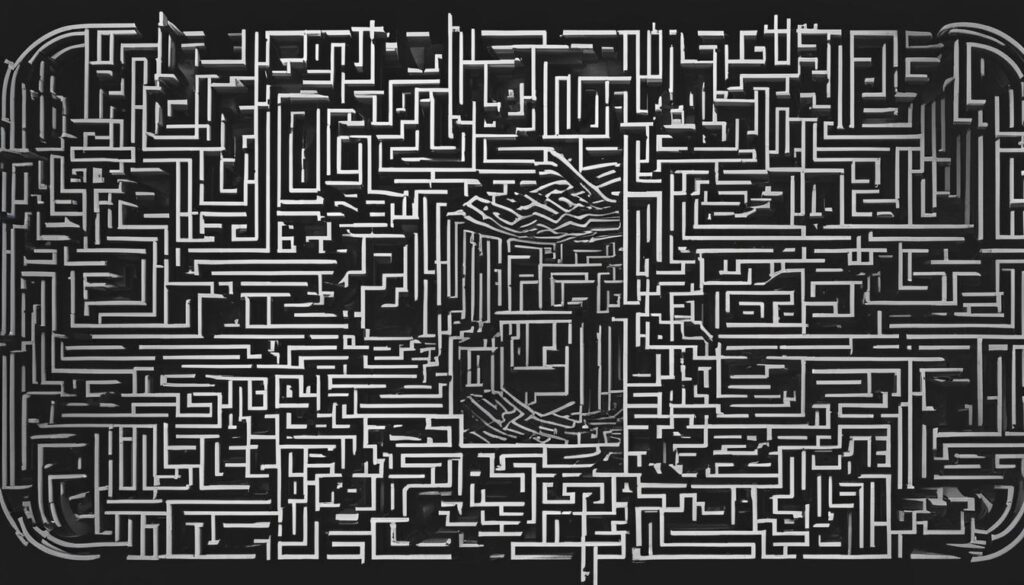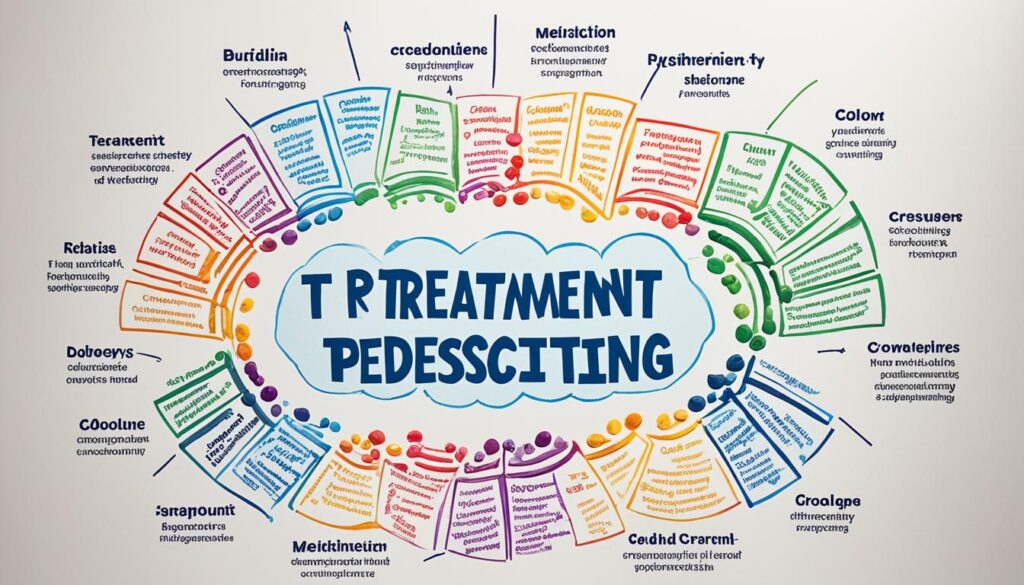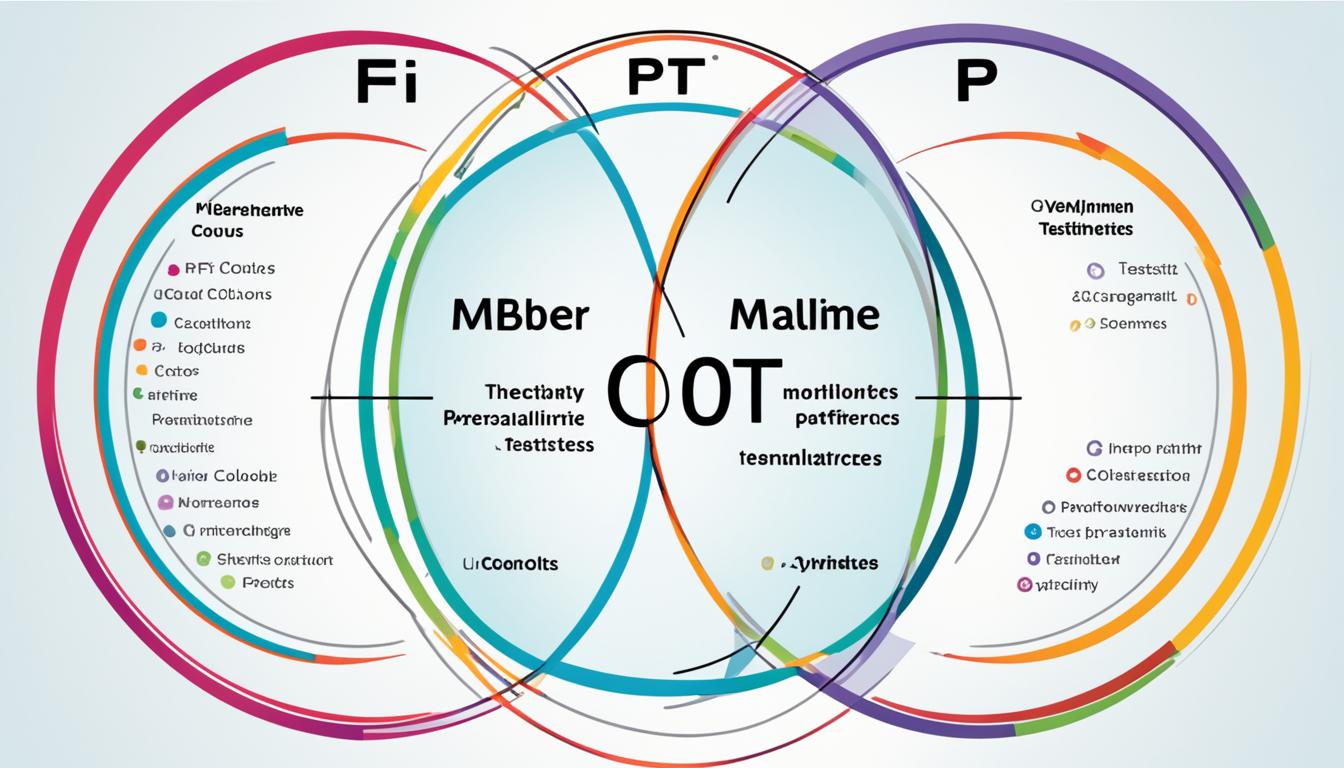Were you aware that 1.6% of the overall population is impacted by Borderline Personality Disorder (BPD)? This percentage represents a considerable number of people potentially facing the challenges of this intricate mental health issue.
BPD can manifest in various ways, with high-functioning BPD being a subtype that can be harder to spot. Individuals with high-functioning BPD may hide their negative emotions, presenting a façade of normalcy to the outside world. However, they still experience symptoms such as perfectionism, feelings of emptiness and loneliness, and a constant need for approval.
Curious if you or someone you know may have high-functioning BPD? Taking a high-functioning BPD test can provide valuable insights into the presence of symptoms and help uncover the appropriate support needed.
Key Takeaways:
- Borderline Personality Disorder (BPD) affects 1.6% of the general population.
- High-functioning BPD can be harder to spot due to the masking of negative emotions.
- Common symptoms of high-functioning BPD include perfectionism, feelings of emptiness, and approval-seeking behavior.
- Taking a high-functioning BPD test can help individuals understand their symptoms and seek appropriate support.
- Early diagnosis and treatment are crucial in managing high-functioning BPD and preventing negative impacts on various aspects of life.
Types of BPD
Borderline personality disorder (BPD) manifests in various forms, each with distinct characteristics and symptoms. Understanding these different subtypes can provide valuable insight into the complexities of the disorder.
Petulant BPD
In petulant BPD, individuals exhibit a strong desire for control and power. They often rely on passive-aggressive tactics to maintain their dominance and may express their frustration indirectly. This subtype is associated with stubbornness and a persistent need for validation.
Impulsive BPD
Impulsive BPD is marked by impulsive behaviors and a tendency to engage in risky activities without considering the consequences. These individuals may struggle with self-control and have difficulty managing their emotions, leading to unpredictable actions.
Self-Destructive BPD
The self-destructive subtype of BPD is characterized by intense feelings of self-hatred and bitterness. Individuals with this subtype may engage in self-sabotaging behaviors or self-harm as a way to cope with their emotional pain. They often have a negative self-image and struggle with low self-esteem.
High-Functioning BPD
High-functioning BPD, also known as quiet BPD, is deceptive in nature as individuals appear to lead successful lives while grappling with intense internal struggles. This subtype is associated with an excessive need for perfectionism, feelings of emptiness, and a strong inclination for seeking approval from others. Despite their outward accomplishments, individuals with high-functioning BPD may experience profound emotional distress.
In summary, the different types of BPD—petulant, impulsive, self-destructive, and high-functioning—reveal the multifaceted nature of this complex disorder. Each subtype presents its own challenges and requires tailored approaches for diagnosis and treatment.
Signs of BPD
Borderline personality disorder (BPD) is a complex mental health condition characterized by various signs and symptoms that can significantly impact an individual’s life. While each subtype of BPD may have specific manifestations, there are common signs that can indicate the presence of the disorder.
1. Intense Mood Swings
Individuals with BPD often experience dramatic and rapid shifts in their emotional state. They may go from feeling happy and euphoric to intense sadness or anger in a matter of minutes or hours. These mood swings can be triggered by seemingly insignificant events and may seem excessive or disproportionate.
2. Self-Destructive Behavior
People with BPD may engage in self-destructive behaviors as a way to cope with their emotional pain or regulate their intense emotions. This behavior can manifest as self-harm, substance abuse, reckless driving, or engaging in risky sexual activities.
3. Fear of Abandonment
Individuals with BPD often have an intense fear of being abandoned or rejected by others. They may go to great lengths to avoid real or perceived abandonment, which can lead to clingy or dependent relationships. This fear can trigger extreme emotional reactions and behaviors.
4. Unstable Relationships
People with BPD tend to have volatile and unstable relationships characterized by intense love and admiration one moment, followed by anger, resentment, and devaluation the next. This pattern of idealization and devaluation can strain relationships, leading to frequent conflict and difficulties in maintaining long-term connections.
5. BPD Splitting
BPD splitting is a unique feature of the disorder that involves perceiving things, situations, or people as either all good or all bad, with little room for gray areas. This black-and-white thinking can lead to rapid shifts in opinions, judgments, and attitudes towards others, often causing conflict and confusion in relationships.
It is important to note that while these signs can be indicative of BPD, they can also overlap with other mental health disorders, such as bipolar disorder and histrionic personality disorder. A comprehensive evaluation by a mental health professional is necessary to accurately diagnose BPD and develop an appropriate treatment plan.

| Signs of BPD | Description |
|---|---|
| Intense Mood Swings | Dramatic shifts in emotions from extreme happiness to intense sadness or anger. |
| Self-Destructive Behavior | Engaging in behaviors that harm oneself, such as self-harm, substance abuse, or risky activities. |
| Fear of Abandonment | An intense and irrational fear of being abandoned or rejected by others. |
| Unstable Relationships | Volatile and unpredictable relationships characterized by idealization and devaluation. |
| BPD Splitting | Perceiving people, situations, or things as either all good or all bad, with little middle ground. |
Causes & Risk Factors
Borderline personality disorder (BPD) is a complex mental health condition with multifactorial causes. While the exact etiology is not fully understood, research suggests that both genetic and environmental factors contribute to the development of BPD.
Genetics play a role in the risk of developing BPD. Twin studies have shown a higher concordance rate for BPD in monozygotic twins compared to dizygotic twins, implying a genetic influence. Recent research has identified specific genes that may be associated with BPD, including DPYD and PKP48, although further studies are needed to fully understand their impact.
Brain function abnormalities have also been observed in individuals with BPD. Research using neuroimaging techniques has indicated dysregulation in areas of the brain involved in emotion regulation, such as the prefrontal cortex and amygdala. These abnormalities contribute to the emotional instability and impulsivity seen in individuals with BPD.
Environmental factors, particularly childhood trauma, also play a significant role in the development of BPD. Individuals who have experienced physical or sexual abuse, neglect, abandonment, or family dysfunction during their formative years are at a higher risk of developing BPD. Childhood trauma disrupts normal psychological development, leading to maladaptive coping strategies and difficulties in emotional regulation.

Research suggests that both genetic and environmental factors contribute to the development of BPD. Genetic influence is observed in twin studies, and certain genes, such as DPYD and PKP48, may be associated with the disorder. Brain imaging studies reveal abnormalities in areas related to emotion regulation. Childhood trauma, including abuse, neglect, and family dysfunction, is a significant environmental factor associated with BPD.
Untreated High-Functioning BPD Effects
Untreated high-functioning borderline personality disorder (BPD) can have detrimental effects on various aspects of an individual’s life. Without proper treatment and support, the negative consequences of high-functioning BPD can manifest in several ways:
- Job loss: Difficulties in regulating emotions and relationships can lead to workplace conflicts and impair job performance.
- Unstable and dangerous relationships: Intense mood swings and fear of abandonment can strain interpersonal connections, leading to a series of tumultuous and potentially harmful relationships.
- Marital stress: The challenges of navigating high-functioning BPD can create significant strain within marriages and partnerships.
- Loss of friends and support systems: The unpredictable nature of BPD symptoms can result in the loss of friendships and support networks.
- Substance abuse: Individuals with untreated high-functioning BPD may turn to substances as a way to cope with their emotional struggles.
- Legal issues: Impulsivity and risk-taking behaviors can result in legal consequences.
- Suicide: The untreated high-functioning BPD is associated with increased suicidal ideation and completed suicides.
Mood disorders, such as depression and anxiety, are highly comorbid with high-functioning BPD. Untreated BPD can exacerbate these mood disorders, amplifying the negative impact on an individual’s mental well-being. Seeking appropriate treatment and support is crucial to mitigate the adverse effects of high-functioning BPD and promote a healthier, more fulfilling life.
In the next section, we will explore the diagnostic process for high-functioning BPD and the criteria used by clinicians to make an accurate diagnosis.

High-Functioning BPD Diagnosis
Diagnosing high-functioning borderline personality disorder (BPD) requires a comprehensive evaluation by a licensed clinician. Unlike other medical conditions, there is no specific test for BPD. Instead, clinicians rely on the criteria outlined in the American Psychiatric Association’s Diagnostic and Statistical Manual of Mental Disorders (DSM-V) to make an accurate diagnosis.
In order to receive an official BPD diagnosis, an individual must meet five out of the nine criteria specified in the DSM-V. These criteria encompass a range of symptoms and behaviors associated with BPD, including unstable relationships, intense fear of abandonment, identity disturbance, chronic feelings of emptiness, and impulsivity.
Diagnosing BPD can be challenging due to the overlapping symptoms it shares with other mental health disorders such as bipolar disorder and histrionic personality disorder. Additionally, the presentation of BPD may vary among individuals, making it crucial for clinicians to conduct a thorough assessment to ensure an accurate diagnosis.
Seeking a professional evaluation is the first step towards understanding and managing high-functioning BPD. A licensed clinician will utilize their expertise and the DSM-V criteria to form a diagnosis, paving the way for appropriate treatment and support.

| DSM-V Criteria for BPD Diagnosis |
|---|
| 1. Frantic efforts to avoid real or imagined abandonment. |
| 2. Unstable and intense interpersonal relationships, characterized by alternating between extremes of idealization and devaluation. |
| 3. Identity disturbance, persistently unstable self-image, and/or sense of self. |
| 4. Impulsivity in potentially self-damaging areas (e.g., substance abuse, reckless driving, binge eating). |
| 5. Recurrent suicidal behavior, gestures, or threats, or self-mutilating behavior. |
| 6. Affective instability due to a marked reactivity of mood (e.g., intense episodic dysphoria, irritability, or anxiety usually lasting a few hours and only rarely more than a few days). |
| 7. Chronic feelings of emptiness. |
| 8. Inappropriate, intense anger or difficulty controlling anger (e.g., frequent displays of temper, constant anger, recurrent physical fights). |
| 9. Transient, stress-related paranoid ideation or severe dissociative symptoms. |
BPD Treatments
When it comes to tackling borderline personality disorder (BPD), effective treatment is key in managing symptoms and enhancing overall well-being. At our clinic, we offer a range of therapeutic approaches tailored to meet the unique needs of individuals with BPD.
Cognitive-Behavioral Therapy (CBT)
One of the most widely used therapeutic techniques for BPD is cognitive-behavioral therapy (CBT). CBT aims to help individuals identify and change negative thinking patterns and behaviors that contribute to emotional distress. Through CBT, our experienced clinicians guide clients in managing emotions, developing healthy coping mechanisms, and fostering positive relationships. By focusing on emotion regulation and behavioral changes, CBT equips individuals with the tools they need to navigate the challenges associated with BPD.
Medication
In some cases, medication may be prescribed to address specific symptoms associated with BPD, such as anxiety, depression, or mood swings. Medications can help stabilize mood, reduce anxiety, and improve overall mental well-being. Our team of psychiatrists works closely with clients to develop personalized medication plans that align with their unique needs and complement other therapeutic interventions.
Holistic Methods
At our clinic, we believe in a holistic approach to BPD treatment, recognizing that the mind and body are interconnected. In addition to traditional therapies, we offer a range of holistic methods that can complement and enhance the overall treatment experience. These include mindfulness practices, relaxation techniques, art therapy, and yoga. These holistic modalities can help individuals develop a greater sense of self-awareness, improve mood, reduce stress, and cultivate a greater overall sense of well-being.
Education and Life Skills
Education seminars and life skills classes play a crucial role in BPD treatment. These programs provide individuals with valuable knowledge about their disorder, its symptoms, and coping strategies. By equipping clients with essential life skills, such as emotion regulation techniques, effective communication, and problem-solving, we empower them to navigate their daily lives with greater confidence and resilience.
At our clinic, we understand that BPD treatment is not a one-size-fits-all approach. Each treatment plan is carefully tailored to meet the individual needs and goals of our clients. Combining evidence-based therapies, medication when appropriate, holistic methods, and educational programs, we strive to provide comprehensive and effective care that supports every aspect of our clients’ well-being.

Quiet BPD: The Subtle Form
Quiet borderline personality disorder (BPD) is a term used to describe individuals who experience BPD symptoms but do not openly display them. While their emotions may be just as intense as those with high-functioning BPD, these individuals direct their emotions inwards, making it harder to identify their struggles. Some common symptoms of quiet BPD include intense fears of abandonment, self-inflicted injuries, anxiety, and mood swings.
Living with quiet BPD can be challenging, as individuals may struggle with harmful self-talk and experience emotional disparities that affect their daily life and relationships. The internal turmoil they experience is often hidden from others, making it difficult for them to receive the support and understanding they need.
“Living with quiet BPD often feels like a constant battle with myself. I experience intense emotions, but I keep them bottled up, fearing judgment and rejection. It’s an internal struggle that no one else sees or understands.”
Self-talk plays a significant role in the lives of individuals with quiet BPD. The constant negative self-talk can perpetuate feelings of inadequacy, self-doubt, and shame. These individuals may find it challenging to believe in their own abilities and worthiness, leading to a constant need for external validation and approval.
Moreover, emotional disparities are prevalent among those with quiet BPD. They may experience significant emotional highs and lows, which can be exhausting and overwhelming. These emotional fluctuations can impact their relationships, causing instability and misunderstandings.
It is essential for individuals with quiet BPD to seek help and support. Therapy, specifically dialectical behavior therapy (DBT), can be an effective treatment approach to manage and regulate emotions, improve self-talk, and develop healthier coping mechanisms. With proper support and understanding, individuals with quiet BPD can learn to navigate their emotions and build fulfilling, meaningful lives.

| Symptoms of Quiet BPD | Impact of Quiet BPD |
|---|---|
| Anxiety | Difficulty forming and maintaining relationships |
| Intense fears of abandonment | Feelings of loneliness and isolation |
| Self-inflicted injuries | Struggles with self-esteem and self-worth |
| Mood swings | Internalized sense of shame and guilt |
Childhood Trauma and BPD
Childhood trauma is a significant factor in the development of borderline personality disorder (BPD). Traumatic experiences, such as physical or emotional abuse, neglect, and family dysfunction, can have lasting effects on a person’s mental and emotional well-being.
During early childhood, when an individual’s brain and coping mechanisms are still developing, trauma can disrupt the natural processes and lead to maladaptive coping strategies. The mind may split as a defense mechanism, trying to navigate the overwhelming emotions and experiences.
This internalized sense of abandonment and emotional instability, stemming from childhood trauma, can contribute to the development of BPD later in life. The impact of childhood trauma on BPD cannot be ignored, as it shapes the individual’s perception of themselves and others, as well as their ability to regulate emotions and maintain stable relationships.

Understanding the connection between childhood trauma and BPD is crucial in providing appropriate support and treatment for individuals affected by this complex disorder. By addressing the root causes and helping individuals heal from their traumatic experiences, we can work towards promoting resilience, emotional stability, and healthier relationships.
It is important to approach individuals with BPD and a history of childhood trauma with empathy and compassion, creating a safe environment where they can explore and heal from their past experiences.
Conclusion
Borderline personality disorder (BPD) is a complex mental health condition that can have a profound impact on an individual’s daily life and relationships. High-functioning BPD, characterized by concealed negative emotions, perfectionism, and an intense desire for approval, can be difficult to detect.
Early diagnosis and appropriate treatment are paramount in effectively managing BPD symptoms and mitigating their negative effects on various aspects of life. Seeking professional support from mental health experts and exploring a range of treatment options, including therapy and medication, can empower individuals with BPD to live fulfilling and meaningful lives.
It is crucial to recognize the importance of understanding and addressing BPD. With the right tools and resources, individuals with BPD can cultivate healthier coping mechanisms, regulate their emotions, and cultivate more stable and fulfilling relationships. BPD is a journey, and with the right guidance and support, individuals can overcome the challenges and create a brighter future.
What Are the Key Differences Between BPD Test and the East West North South Personality Test?
The key differences between the BPD test and the East West North South personality test lie in their approach and focus. The BPD test is designed to assess Borderline Personality Disorder, while the East West North South personality test evaluates personality traits based on directional preferences. Choose the right personality test for you.
FAQ
What is a high-functioning borderline personality disorder (BPD) test?
A high-functioning BPD test is a screening tool that helps individuals assess their symptoms and determine if they may have high-functioning BPD. It can provide insight into hidden negative emotions, perfectionism, feelings of emptiness, and approval-seeking behavior.
What are the four types of BPD?
The four types of BPD are petulant BPD, impulsive BPD, self-destructive BPD, and high-functioning BPD.
What are the signs of BPD?
Signs of BPD can include intense mood swings, fear of abandonment, unstable relationships, BPD splitting (viewing things as all good or all bad), and comorbidity with other mental health disorders.
What causes borderline personality disorder?
The exact causes of BPD are not fully understood, but genetic factors, brain function abnormalities, and childhood trauma are believed to contribute to the risk of developing BPD.
What are the effects of untreated high-functioning BPD?
Untreated high-functioning BPD can lead to negative effects such as job loss, unstable relationships, substance abuse, mood disorders, and even suicide.
How is high-functioning BPD diagnosed?
Diagnosing high-functioning BPD involves a comprehensive evaluation by a licensed clinician who assesses an individual’s symptoms against the criteria outlined in the DSM-V.
What are the treatments for BPD?
BPD treatments may include cognitive-behavioral therapy (CBT), medication for symptom management, holistic approaches, and life skills classes tailored to the individual’s needs.
What is quiet BPD?
Quiet BPD, also known as high-functioning BPD, is a subtle form of BPD where individuals may not outwardly show symptoms but experience intense fears of abandonment, self-inflicted injuries, anxiety, and mood swings.
Is childhood trauma associated with BPD?
Yes, childhood trauma, such as abuse, neglect, and family dysfunction, is a significant factor in the development of BPD. Traumatic experiences disrupt proper development and coping mechanisms, contributing to BPD later in life.
What is the conclusion about BPD?
Borderline personality disorder is a complex mental health disorder that can significantly impact an individual’s daily functioning and relationships. Early diagnosis and appropriate treatment are crucial for managing symptoms and preventing negative consequences.
Emmeline is the backbone of our content creation team, bringing complex psychological concepts to life with clarity and empathy. As our Expert Writer, she crafts engaging, insightful articles that guide readers through the intricacies of personality assessments and what they reveal about the human condition. Her passion for psychology and personal development shines through in every piece she writes.










